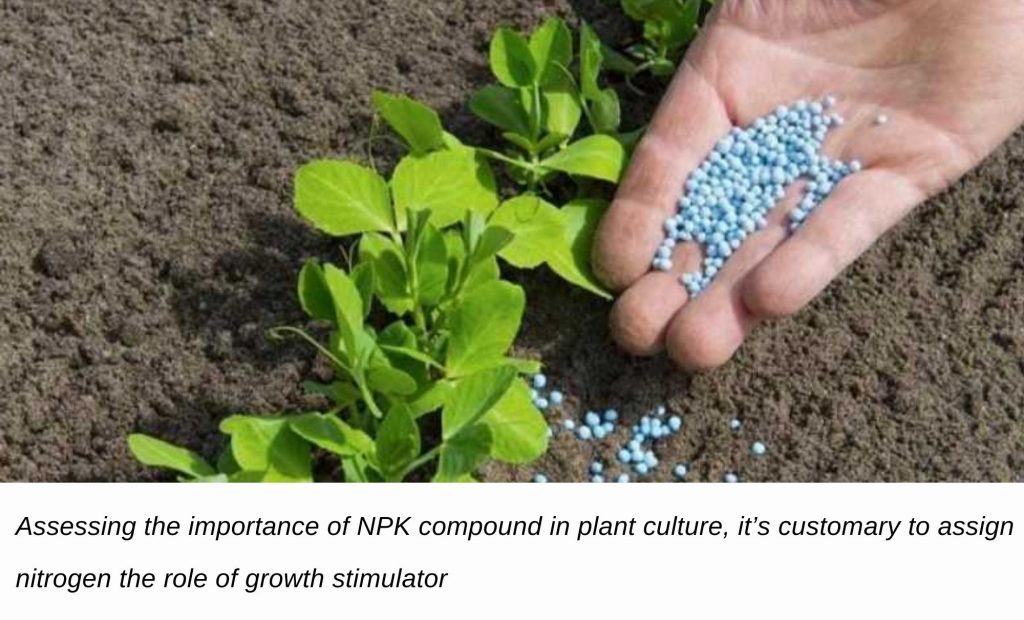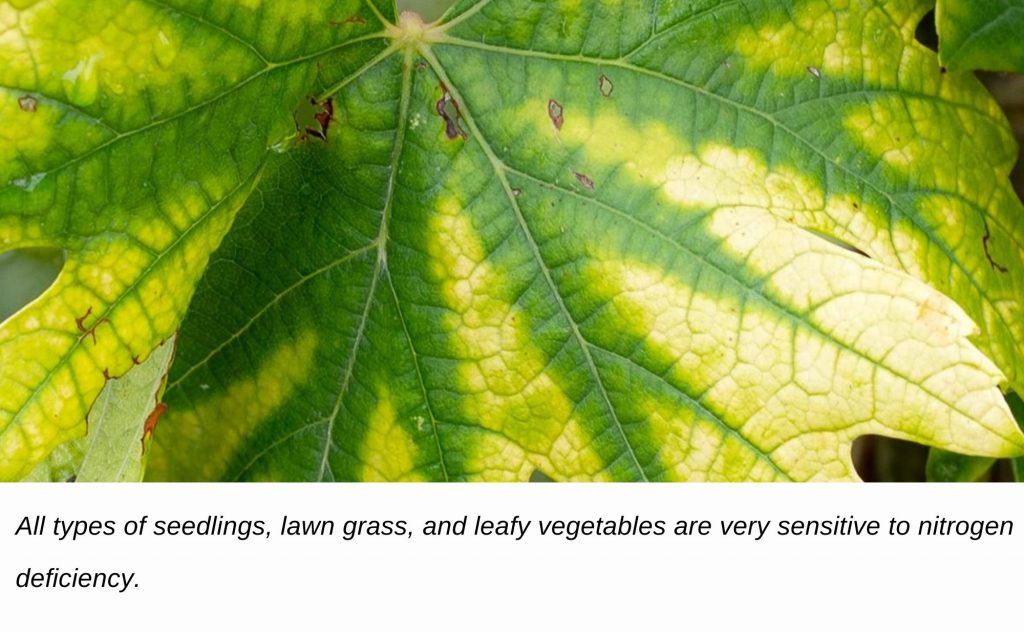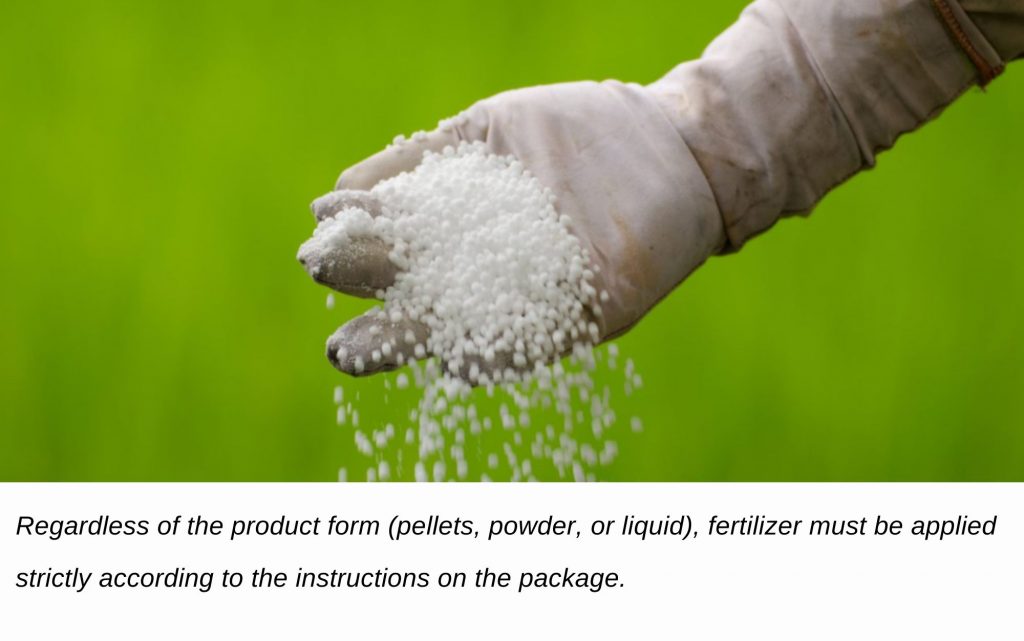Plants, animals, and people depend on the availability of oxygen, carbon, hydrogen, and nitrogen. Plants get the right amount of nutrients, including this one, from the soil. If there’s no soil to talk about or it’s of the loamy and sandy type, fertilizer must be provided. You simply can’t get a crop without it. It’s difficult to name the best nitrogen fertilizer for plants: each case requires an individual approach.
Role of nitrogen fertilizer
Nitrogen is one of the most important macronutrients found in every part of a plant. It is an important component of chlorophyll, which gives plants their green coloration. This nutrient is easily leached from the soil, and providing it in sufficient quantitie contributes to the full development of the plant.

Assessing the importance of NPK compound in plant culture, it’s customary to assign nitrogen the role of growth stimulator, while phosphorus is responsible for flowering and potassium for fruiting. In addition to its main role, the nutrient helps to grow not only green mass but also flowers and fruits. Nitrogen not only increases the size of fruits and vegetables but also their quality.
Classification of nitrogen fertilizers
Nitrogen fertilizers are compounds, the main purpose of which is to increase the level of the nutrient and, as a consequence, to increase crop yields. They are necessary for the plant for proper development and growth. The mineral fertilizers can differ from each other by the mass content of the macronutrient.
All nitrogen fertilizers are classified into five important groups. The main criterion for classification is the form of the nitrogen-containing compound.
Group One. Nitrate fertilizers. This group includes sodium nitrate and calcium nitrate.
Group two. Ammonium fertilizers. This group includes such fertilizers as ammonium sulfate and ammonium chloride.
Group three. Ammonium-nitrate fertilizers or ammonium-nitrate fertilizers. This is a complex group that combines ammonia and nitrate fertilizers. A prime example is ammonium nitrate.
Group four. Amide fertilizers. Urea is the main fertilizer of this group.
Group five. Liquid ammonia fertilizers. The fifth group includes anhydrous ammonia and ammonia water.
Based on the physical state, fertilizers are classified into liquid and solid. The liquid form is widely used in agriculture, as it is more economical from a financial standpoint. Ammonia is the main component of liquid fertilizers. Liquid ammonia and aqueous ammonia solution are the most common liquid fertilizers.
Benefits of nitrogen fertilizers
Nitrogen fertilizers are the solution to problems related to growth, plant development, and soil fertility. When the soil is enriched with them, you can see the results:
- Acceleration of plants’ vegetative organs growth;
Plants are saturated with amino acids; - The degree of saturation of plant tissues with water increases;
- The volume of the cell increases and the cuticle and sheath become thinner;
- The rate of mineralization of additives applied to the soil increases;
- Activation of the soil microflora;
- Pests are actively extracted from the soil;
- The ratio of Nitrogen to Carbon elements in the soil is greatly improved;
- The increase in the value of compensatory abilities responsible for the reaction of plants to various kinds of damage;
- Significant increase in yields.
As we all know from the school biology course, nitrogen is the main component of proteins. And proteins are a part of the cytoplasm of the cell nucleus. Nitrogen is part of many substances that play a crucial role in shaping the development of living organisms and participate in the metabolic processes of plant matter. Both nucleic acids and enzymes and vitamins are rich in nitrogen content. The conclusion is obvious, nitrogen fertilizer is the basis of life.

Nitrogen excess and deficiency
If you are going to use liquid nitrogen fertilizers for your plants, its meaning and application should be carefully considered. An excess of nutrients is just as harmful as a deficiency.
Signs of nitrogen deficiency
If plants lack the nutrient, it manifests in such ways as:
- Retarded growth;
- Leaves become small, turn yellow quickly, and their edges begin to dry out;
- Flowers get fewer and weaker;
- There’s a significant drop in yields.
All types of seedlings, lawn grass, and leafy vegetables are very sensitive to nitrogen deficiency. It’s extremely important to ensure the adequate supply of the nutrient when the plants begin their vegetation period.
Signs of nitrogen excess
The excess of the nutrient leads to the following consequences:
- The plants get fat, which is especially noticeable on tomatoes, cucumbers, and other fruited vegetables. The bushy plants ramp up greenery without yielding fruit;
- Berry and fruit perennials freeze even during warm winters if you overfeed them with nitrogen after midsummer. This happens because of the increased water content in the shoots;
- Fruits rot quickly and don’t last long at all;
- Plants become vulnerable to pests and diseases;
- Nitrates accumulate in greens and fruits.
Types of Nitrogen fertilizers
Manufacturers produce different types of nitrogen-containing fertilizers, each with special features and application times. The list of the most popular names includes the following:
1. Ammonium nitrate (up to 35% nitrogen)
Advantages: it can be easily diluted with water, immediately assimilated. Can be applied in early spring.
Disadvantages: it can be applied only to alkaline and neutral soils, it’s not used for foliar application. If stored in a humid place, might form lumps. Overdose causes the death of plants.
Apply in spring and fall, as well as in summer, as a soil dressing.
2. Urea (46% nitrogen)
Advantages: easily dissolved and assimilated.
Disadvantages: quickly weathered and washed out of the soil, so requires deeper application than usual. It’s used on alkaline and neutral soils, as it increases the acidity of the soil.
Such nitrogen mineral fertilizers are applied as a top dressing in the spring and summer.
3. Ammonium sulfate (20% nitrogen)
Advantages: it doesn’t get caked during storage, is easily dissolved, and doesn’t get washed out. In addition to nitrogen, it contains 24% sulfur, which positively affects crop quality and shelf life.
Disadvantages: used only in alkaline soils because it strongly acidifies the soil.
Applied in autumn.
4. Calcium nitrate (15.5% nitrogen)
Advantages: it dissolves well, prevents crop damage by apical rot.
Disadvantages: requires protection from moisture during storage, otherwise it dissolves.
It’s used in neutral and acidic soils in the form of spring and summer dressings.
5. Sodium nitrate (16% nitrogen)
This is sodium salt of nitric acid.
Advantages: it’s easy to dissolve, and also contains sodium the root vegetables love so much.
Disadvantages: freezes during storage and is quickly washed out of the soil. Used only on acidic soils. The substance irritates unprotected skin and is dangerous for animals. Can’t be used in a greenhouse under any circumstances.
6. Manure
Manure can’t be left out of the list of nitrogen fertilizers. It’s the best-known and most common organic fertilizer. Considering that manure and dung contain only 0.5% and 2.5% nitrogen respectively, really large doses would be needed.
Advantages: apart from nitrogen, manure contains phosphorus, calcium, potassium, and magnesium. It’s a natural substance that can improve soil structure.
Disadvantages: it might contain weed seeds and is quite difficult to dose.
Semiprepared (not fresh) manure is introduced into the soil in autumn. If the fertilizer is completely decomposed, it is added to the holes for planting.
Nitrogen-containing compounds
Nitrogen primarily affects the formation of green mass and is therefore used in the spring. But plants also need other components to promote growth and development. In particular, phosphorus, which helps plants set fruit and increases winter hardiness, as well as potassium, which promotes resistance to disease and adverse weather conditions. That’s why gardeners and vegetable growers are increasingly choosing complex fertilizers containing the three main necessary components (nitrogen-phosphorus, nitrogen-potassium, or nitrogen-phosphorus-potassium fertilizers).
Methods of nitrogen fertilizer application
Regardless of the product form (pellets, powder, or liquid), fertilizer must be applied strictly according to the instructions on the package. Manufacturers usually offer recommendations on timing, rationing, and method of application.

As a standard, nitrogen mineral fertilizers are used for the main treatment and often for top dressing. There are restrictions on the timing of the application of substances containing the nutrient. One-component mineral fertilizers aren’t recommended as a basic fertilizer in autumn. Instead, they normally choose fertilizer compounds.
Organics substances based on humus are considered environmentally safe. The main nitrogen-containing compound of this kind is manure. It contains about 0.7% nitrogen and potassium, and up to 0.5% phosphorus.
When planning to use manure during the active growing season, it’s necessary to properly prepare an organic fertilizer. To support the growth and fruiting of tomatoes, prepare a mixture of 30 liters of water and 1 bucket of manure.
Aside from manure, there are bacterial organics. These are fertilizers that contain whole colonies of beneficial bacteria. These bacteria accelerate the transformation of hard-to-reach nutrients into easily accessible ones. Plants absorb nutrients better, and consequently, all the vital processes in them proceed as they should and in time.
Organomineral compounds are a balanced complex of agrochemicals and organics. Liquid, granular, and paste formulas are available. The first ones increase the content of humus in the soil, the others are characterized by a long-term beneficial effect on plants.
Recommended norms for nitrogen fertilizer application
- When planning to use nitric acid as a fertilizer (or any other nitrogen-containing formulations), you should be guided by years of observations of experienced gardeners. It’s important to know the nitrogen requirements of different plant species and the recommended timing of fertilizer application:
- Out of all vegetables, pumpkin and zucchini, peppers, cabbage of all kinds need nitrogen most of all. Among fruit crops, the main consumers of nitrogen are raspberries and their close relative, blackberries, as well as plums of all varieties and cherries. Nitrogen-containing additives also have a pronounced positive effect on ornamental plants. The norm for this group is considered to be 0.7 – 0.8 oz. of pure nitrogen per 10 square feet of plantings.
- Carrots and beets, cucumbers and tomatoes, parsley, and garlic use the nutrient a little less actively. Currants of all kinds, gooseberries and annual flowers also belong to this group of consumers. The rate of application here is about 0.3-0.7 oz. of pure substance (natural or from mineral fertilizers) per 10 square feet.
- Lettuce cabbage, spinach, and radish have a low nitrogen requirement. For their complete growth, 0.3 – 0.5 oz. of nitrogen per 10 square feet is sufficient.
- For some crops, additional nitrogen supplementation is practically unnecessary. These are, first of all, legumes – they get their necessary amount due to the activity of nodule bacteria. Moreover, these plants also return part of the formed N2 into the surrounding soil.

It’s recommended to apply nitrogen-containing additives in the spring or in the fall. At this time, they usually apply 50-75% of the total amount that will be needed during the growing season. As a result, plants starting a new growth cycle or just planted in an open or greenhouse soil immediately get a powerful boost needed to activate their growth processes. The remaining volume should be spread over several summer feedings.
Main rules for fertilizer application
1. To ensure that nitrogen fertilizers have the best possible effect on plant growth and development, as well as soil fertility, it’s recommended to stick to the timing of their application using the best methods.
2. The fall and winter period is a time when nitrogen isn’t stable. Runoff and groundwater wash it out. Consequently, the favorable period to apply the substance is the spring and fall periods.
3. It’s important to consider the diagnostic results of nutrition. Fractional application of the compound increases the quality indicators of nitrogen consumption.
4. Acidic soils absorb the fertilizer better if it’s combined with lime. Preventive liming has a favorable effect on the efficiency of nitrogen fertilizer assimilation.
5. To maximize the effect of assimilation, it’s recommended to combine various forms of the nutrient. For example, they use urea first and then ammonium nitrate during active vegetation.
Tips & recommendations
1. To keep the nitrogen level in the fertilizer from dropping, store it in a place where it’s protected from air and sunlight.
2. The nutrient shouldn’t be applied too deep. Pre-cultivation is ideal. This option will allow nitrogen to penetrate deep into the soil as soon as you moisten it with water or nature gives rain.
3. Take advantage of the knowledge that ammonium compounds readily leach from the soil with meltwater, incorporate them into the soil in the fall.
Conclusion
The application of nitrogen or nitrogen-based fertilizers is useful. Now you know what they are, but don’t forget about the harm that you can cause to plants, soil, and society if you don’t follow the technology of preparation of solutions or disregard mass ratios.
Remember, too much nitrogen reduces the survival of newly transplanted plants and provokes the accumulation of nitrates in fruits. To avoid problems, follow the advice and recommendations of experts, pay attention to the condition of the plants, their appearance, and the development of fruits. Only these indicators will be decisive in choosing whether to use or limit the consumption of nitrogen fertilizers.


